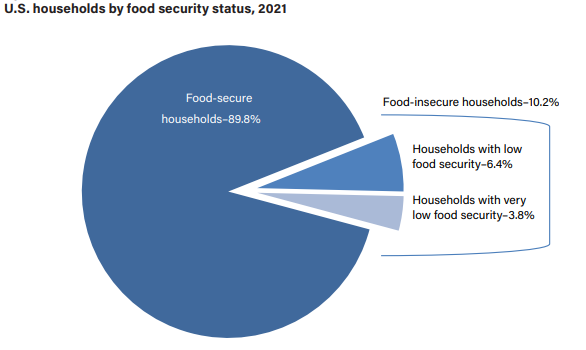Why Is There Hunger in the U.S.?
- According to the US Department of Agriculture, more than 35 million people (10.2%), including 9 million children, in the United States are living with hunger. That’s 1 in 8 kids. Some of these children are missing meals; others are faced with hunger-related hardships as parents and caretakers make tradeoffs between buying groceries or paying bills.
- We have come to measure how many people can’t afford food by “food insecurity.” Food insecurity is defined as a lack of consistent access to enough food for every person in a household to live an active, healthy life. This can be a temporary situation for a family or can last a long time.
- Every community in the country is home to families who face hunger. But rural communities are especially hard hit by hunger.
- Many households that experience food insecurity do not qualify for federal nutrition programs and visit their local food banks and other food programs for extra support.
- Black and Hispanic Americans are particularly disproportionately affected. According to USDA data, 19.1% of Black households and 15.6% of Hispanic households experienced food insecurity in 2019. White Americans fell below the national average, with 7.9% experiencing food insecurity.
- College graduates experienced food insecurity at a rate of just 5% last year. For those without a high school degree, the rate skyrocketed to 27%. Adults who have a disability — in particular adults who have a disability and are not in the work force — also experience more than two times the rate of food insecurity as adults who do not have a disability.
- Unfortunately, many people in America struggle to meet their basic needs, which increases their risk of food insecurity. For example, lay-offs at work, unexpected car maintenance, or an accident can suddenly force a family to choose between buying food and paying bills.
- Poverty, unemployment, or low income
- Lack of affordable housing
- Chronic health conditions or lack of access to healthcare
How Will We Know We Ended U.S. Hunger?
According to new metrics proposed by the National Strategy on Hunger, Nutrition and Health (September 2022), using the Household Food Security in the United States in 2021 report summary from the Economic Research Service, U.S. Department of Agriculture:
Ending hunger will be measured by a reduction in the number of U.S. households with insufficient food (defined as very low food security) to less than 1% of households and cut the number of households struggling to put enough nutritious food on the table (defined as food insecurity) in half.

These statistics are updated annually from previous years' data.
To learn about your community's food insecurity status, check out these interactive maps developed by partner anti-hunger nonprofit organizations:
Interactive Maps:
Food Insecurity by State (Food Research & Action Center)
Food Insecurity by County and Congressional District (Feeding America)

